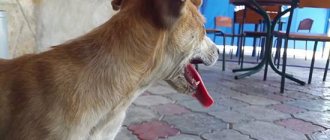11/13/2021 14,334 Diseases and treatment of cats
Author: Olga
Cats are quite often exposed to a variety of colds. And a cough shows that there are problems in the respiratory system. Not everyone knows what to do if a cat coughs. First of all, it is recommended to understand the reasons.
Coughing is a natural protective reaction of the body, which occurs when a foreign body enters the respiratory tract. Accordingly, the cat sneezes and coughs. However, this may be a symptom signaling the onset of a disease.
[Hide]
Possible reasons
If your cat is coughing, you need to consider all sorts of reasons:
- A foreign body (small bone, ball, hairpin, etc.) has entered the respiratory tract. In such a situation, the cat seems to wheeze and sneeze.
- There is acrid smoke and chemical fumes in the room.
- If your cat is coughing, there may be a respiratory viral or bacterial infection. For example, bronchitis or laryngitis.
- Your pet is sneezing and coughing due to an allergic reaction. This suggests that you may have bronchial asthma.
- Fluffy wheezes if there is a disease of the cardiovascular system.
- The kitten may cough if there are worms. These parasites can enter both the lungs and bronchi. There they will develop and cause coughing.
When do you need to go to the vet urgently?
When no manipulations produce results, and the stuck foreign body cannot be removed, then it is necessary to go to the doctor without delay, if it is not possible to call him at home. It is also worth doing if the cause is not something swallowed, but the dog is wheezing and choking. And even if you managed to remove what your pet choked on, this does not guarantee that there is no other, smaller object inside or damage to the larynx. Therefore, the animal should definitely be taken to a veterinarian for examination and ultrasound.
Does your pet actually cough?
The causes of cough in cats and kittens can be very different. And regardless of the fact that the pet sneezes and wheezes quite rarely, with the help of this he can contribute to the functioning of the whole organism. When coughing, the throat is cleared if the kitten or cat is choking.
You can recognize a cough in a furry pet by certain movements. Typically, during this process, the pet stretches its neck down, arches its back and draws in its abdominal wall. At the same time, he wheezes, makes coughing sounds, and sometimes sneezes. In some situations, coughing is accompanied by vomiting.
After watching the video, you will learn exactly how a cat coughs.
Respiratory diseases
A common cold can easily provoke coughing, sneezing, swelling of the mucous membranes, and discharge of pus from the nasal passages and eyes. During this period, it is difficult for the pet to swallow, which is why he stops eating and even drinking. Inflamed airways, fortunately, are easy to treat.
The disease is eliminated with the help of antiviral, antibacterial medications, as well as expectorants or antitussives, which are prescribed depending on the type of cough. To restore and subsequently strengthen the animal’s immunity, the veterinarian prescribes a vitamin complex. As a preventive measure , you should take your cat for vaccination , which will reduce the risk of a serious disease.
Possible symptoms
To determine how to treat your pet, you need to find out the type of symptom:
- Respiratory. The cough in such a situation at the very beginning of the disease is dry. Sputum and pus are not released.
- Cardinal. This is a heart cough. The cause of its occurrence may be an enlargement of the heart muscle. It gradually begins to compress the trachea. In such a situation, the intensity with which the cat coughs and sneezes increases gradually. At the very beginning, the cough is muffled and unproductive.
If your furry creature is coughing and sneezing at regular intervals, you should consult a doctor. He will tell you what to do and how to treat the cat.
Infection with worms
A playful kitten becomes lethargic, suffers from diarrhea, uncontrollable vomiting, and constantly tries to cough up if its body is attacked by worms. If affected by worms:
- the pet's belly is enlarged;
- mucus is released with feces;
- The fur becomes dull and dandruff falls out.
Parasites enter the digestive tract of a domestic cat when it feasts on mice, birds, or eats contaminated food. From the intestines, worms travel to the lungs, are swallowed again when coughing, and sexually mature generations lay eggs. To prevent your pet from dying from intoxication, you will need the help of a veterinarian.
Why does fluffy cough?
The nature of the cough can help determine the causes. If it occurs at night, then in most situations this indicates inspiratory tracheal stenosis.
If a cat sneezes and coughs after physical exertion and excitement, then this can be considered a consequence of the fact that the mucous membrane of the larynx, tongue, trachea or bronchi is irritated. A paroxysmal process can be observed in the presence of asthma and viral infections. It is usually accompanied by inflammation of the upper respiratory tract.
We can talk about pathology of the respiratory tract if there is a loud and constant cough. If it occurs periodically, then this is most likely damage to the alveoli.
If your pet is sneezing and coughing, but the cause cannot be determined, an x-ray examination, laboratory diagnostics, and monitoring of the pet over time may be required.
Self-treatment
When the fluffy starts coughing, it needs to be treated. And only veterinarians can not always cope with this. You can be independent and try to cure the cat.
Getting rid of foreign objects
First of all, you need to figure out whether your pet is really coughing. Maybe he's just sneezing. Usually, when coughing, the fluffy makes a wheezing sound. He begins to open his mouth. Sometimes he even sticks out his tongue. It may feel like the cat is simply suffocating.
Why might a cat cough? Check his mouth and tongue. A foreign object or hairballs may get into the mouth. In order to open the mouth, insert your fingers into it in the area of the corners where there are no teeth. Open your jaws carefully, using caution.
Allergic reaction or lack of moisture
If there is nothing in the mouth, and the cat is sneezing, coughing, stretching its neck, think about whether all this could be due to an allergy. It can be caused by a new substance that has appeared in the house. Remember that allergies occur not only when you eat something, but also when you inhale it. If any item is suspicious, you need to temporarily remove it from the house.
What to do if your pet is coughing? It may simply not have enough moisture. Use humidifiers to improve your furry's breathing comfort. A damp towel, which is recommended to be placed on a working battery, will help with this.
Rid your pet of worms
As mentioned earlier, we need to figure out why the cat is sneezing and coughing. And the reason for this can be worms. In order to get rid of them, you need to purchase special products at the pharmacy and add them to your food. This action should be performed at least once a year.
Actions in case of suffocation
If the animal is choking and suffocating, the dog owner must use one of the special techniques. You also need to know the list of prohibited actions:
- Don't hit your dog on the back. This is an ineffective and dangerous method, due to which the choking object may fall deeper into the trachea, which will aggravate the situation. Animals of small breeds should not be hit on the back, because the thin spine is very easy to damage.
- Do not pour vegetable oil down your throat. It will not help the foreign object slip out, and the owner will lose valuable time saving the pet.
The main thing is not to panic, not to scream. This will worry the pet even more: it may not give in to help. You need to calm down, gently but firmly take your pet and take actions to help save his life:
- Use the gravity of the earth. The four-legged friend must be taken by the hind limbs and lifted slightly. Small rocks can even be lifted off the ground by holding them head down. To avoid damaging the spine, you should hold the dog by the neck. A large or medium-sized dog only needs to be lifted slightly. The foreign object should fall out of the throat on its own - if it does not sink deeply.
- The Heimlich maneuver, used for humans and animals. The pet is grabbed from the back at the waist. Then they find the place where the ribs end and the stomach is located. A folded fist is placed there, another hand is placed on top, then rhythmically squeezed upward. Due to the contraction of the esophagus and trachea, the object will pop out. Don't press too hard to avoid breaking the ribs. You need to be extremely careful with small breeds.
- Removing a foreign object manually. The dog's mouth is opened, it is firmly fixed and, illuminated with a flashlight, a foreign body is discovered. The next step is to remove it with tweezers or your fingers. The main task is not to injure the mucous membrane of the throat or palate.
If the dog has lost consciousness, resuscitation measures are carried out. They involve pressing on the chest in a certain rhythm: 15 rhythms per 1 breath. The rescued and calmed pet is taken to the veterinarian. Knowing first aid techniques can help save your pet's life.
Under the supervision of a doctor
If all of the above steps have been completed, and the cat is still sneezing and coughing, you need to contact a veterinarian. You should also consult a doctor if your pet begins to eat less and avoid communicating with people and other cats. In such situations, only a doctor should treat.
What to do if you can’t treat yourself? In such a situation, a set of special measures will be required that only a professional can perform. We are talking about laboratory tests, clinical examination, diagnostics of internal organs.
If the cough is a reflex, you just need to eliminate the cause. There is no need to do anything else, as the cat’s condition has stabilized. Coughing attacks will stop tormenting him.
Bronchial asthma will require treatment for a long time. In some situations, this can last for the rest of the pet's life. From a therapeutic standpoint, antihistamines and hormonal drugs are used.
Asthma is usually seasonal. Signs appear most often in summer and autumn. Accordingly, it is recommended to give medications in advance so that during the next attack the cat does not crane his neck and lie on the floor trying to clear his throat.
Invasive cough can be completely prevented if preventive deworming is carried out. It is recommended to do this procedure once every six months.
Use of antibiotics
If a cat cranes his neck, coughs while lying on the floor, and wheezes due to problems with the cardiovascular system, then a veterinarian should treat him. In such a situation, the owner does not need to do anything on his own.
Antibiotics should be used if the cause of cough is respiratory diseases. You may also need expectorant medications, which are designed to alleviate the animal's condition by reducing coughing. A doctor should prescribe such medications.
It is worth understanding that if you have a dry cough, it is not recommended to use drugs that help get rid of a wet cough. There are times when medications to help stop this process are not given at all. Without them, in some situations, treatment can proceed faster due to the removal of harmful microorganisms during coughing.
Types of cough in children
Cough is a common problem that all children face sooner or later. It can be different in nature (wet, dry, barking, with reprises), in duration (acute or chronic), as well as in the possibility of establishing the cause of the cough (specific or nonspecific), etc.
The first thing a pediatrician does when diagnosing a child’s condition is to determine the type of cough and, based on this, select treatment tactics. In this article we will try to give a detailed description of the main types of cough.
Moist cough
In most cases, the cause of a wet cough is the so-called postnasal drip - the flow of mucous secretions down the back wall of the throat. The situation occurs when there is an infectious inflammation of the nasopharynx or sinuses.
Much less frequently, a wet cough can be triggered by the production of sputum in the lower respiratory tract. This is observed with bronchitis or pneumonia.
A frequent wet cough can be caused by taking various expectorants.
Dry cough
Typically, a dry cough occurs in children with a respiratory tract infection. However, in some cases, a long-lasting dry cough may indicate that a child has bronchial asthma.
Barking cough
This species can be easily identified by its characteristic sound - the cough resembles the barking of a dog or seal. A barking cough occurs during an episode of stenotic laryngotracheitis (false croup). The cause is viral infections.
Typically, the cough occurs at night and is often accompanied by heavy breathing and hoarseness.
Cough with reprises
Symptoms of a recurring cough are frequent coughing impulses, continuously coming one after another. Between the shocks the child does not have time to inhale air. The episode of coughing tremors ends with a noisy inhalation - that is, a reprise.
A recurring cough occurs during the paroxysmal period of whooping cough. In addition, the causes may be some viral infections (parainfluenza, adenoviral infection, respiratory syncytial, etc.), mycoplasma infection or parapertussis.
Acute cough
An acute cough is defined as a cough lasting less than 2 weeks. Basically, the acute form occurs with viral respiratory tract infections (ARVI).
ARVI in healthy children can occur several times a year. Children attending kindergarten get sick more often - the incidence reaches 6-12 episodes annually. A cough with ARVI lasts about 1-3 weeks.
According to research, 50% of preschool children do not have a cough by the 10th day after the onset of the disease, 90% by the 25th day.
At the moment, there is no effective and safe cough remedy for ARVI. Treatment for uncomplicated ARVI should only include drinking plenty of fluids and taking antipyretic medications to relieve discomfort from high fever. Taking antibiotics for ARVI is not advisable, since it does not shorten the duration of the disease and does not reduce the likelihood of complications.
Antiviral drugs have only been proven effective against the influenza virus. Such remedies can shorten the duration of the disease by several days. However, they cannot reduce the risk of complications and the frequency of hospitalization.
In medicine, there is the concept of “red flags” - symptoms, if they occur, you should definitely show the child to the doctor.
“Red flags” for acute cough:
- progressive deterioration in health;
- no improvement within 10 days;
- presence of fever for more than 5 days;
- difficulty breathing;
- the occurrence of extraneous noise when breathing.
In addition, there are conditions when radiography is indispensable. This study is indicated in the following cases:
1. Cough in a child with prolonged fever, rapid breathing or the presence of moist rales in the lungs.
2. Atypical course of the disease with increasing cough or the appearance of hemoptysis.
3. Suspicion of the presence of a foreign body in the respiratory tract.
Chronic cough
A cough lasting more than 4 weeks is called chronic. It is important not to confuse a chronic cough with a recurrent acute cough caused by re-infection.
In order to establish the cause of a chronic cough, it is necessary to carefully collect anamnesis, conduct an examination and undergo several types of studies:
- chest x-ray;
- spirometry;
- tuberculosis screening.
Based on the results obtained, the doctor may prescribe additional laboratory and instrumental studies.
Depending on the possibility of identifying the cause of cough, chronic specific and chronic nonspecific cough are divided.
Chronic specific cough
A cough is called specific, the cause of which can be determined by anamnesis, examination results, instrumental or laboratory examination.
The most common causes of chronic specific cough:
- bronchial asthma;
- bronchiectasis;
- cystic fibrosis;
- eosinophilic pneumonia;
- foreign body aspiration;
- interstitial lung diseases;
- immunodeficiency states;
- exposure to tobacco smoke;
- tuberculosis;
- whooping cough;
- prolonged bacterial bronchitis;
- developmental abnormalities of the respiratory system;
- psychogenic cough;
- taking certain medications, etc.
Chronic nonspecific cough
A cough is called nonspecific, the cause of which cannot be determined based on anamnesis, examination and research.
In most cases, chronic nonspecific cough in children occurs as a result of a viral infection and goes away on its own. In this case, the origin of the cough is associated with an increase in the sensitivity of cough receptors after an infection.
If a chronic nonspecific cough occurs, the child must be shown to the doctor again 2 weeks after the onset of the disease. If after this time the cough persists and no new signs have appeared indicating one or another cause of the disease, then there are two tactics for further action:
1. Observation for an additional 2 weeks.
2. Conducting a trial treatment.
If the first tactic was chosen, if the cough persists, a trial treatment is recommended after 2 weeks.
The trial treatment is selected individually, taking into account the nature of the cough (dry or wet).
For dry cough, trial treatment of bronchial asthma is carried out with small doses of glucocorticosteroids for 2-4 weeks.
If this therapy is effective, treatment is canceled after 2-4 weeks, and in case of further resumption of cough, it is re-prescribed.
For a wet cough, a trial antibacterial treatment for protracted bacterial bronchitis is carried out. In this case, the child should experience the following symptoms:
- daily wet cough for 4 weeks;
- lack of data indicating other causes of cough;
- disappearance of cough 2-4 weeks after the start of antibacterial therapy.
A trial of antibiotic therapy should be carried out for at least 2 consecutive weeks. If the cough persists, treatment is extended for another 2 weeks.
Psychogenic cough
I would also like to dwell on the concept of psychogenic cough. It can be diagnosed by a loud cough in the form of repeated frequent single cough shocks, often with a barking tinge. A psychogenic cough is absent when the child is sleeping, intensifies during boredom and weakens (decreases) when the child is passionate about some activity. Often, the appearance of a psychogenic cough is observed after a viral infection.
The duration of such a cough ranges from several weeks to several months. At the same time, no changes are detected during a medical examination or during studies.
Treatment of psychogenic cough comes down to behavioral therapy.
One of the methods is in the evenings, parents together with the child count the number of cough impulses for 30 minutes. After this, for every 10% decrease in cough frequency for 3 consecutive days, the child receives a reward or praise.
Conclusion
The types of cough are varied. And only a specialist can distinguish normal from pathology. Therefore, you should not delay consultation. If a child develops a cough, it is necessary to show him to the pediatrician as soon as possible.
Video “Cough in cats and kittens”
The video will talk about possible diseases that furry pets are susceptible to.
Sorry, there are no surveys available at this time.
Was this article helpful?
Thank you for your opinion!
The article was useful. Please share the information with your friends.
Yes (100.00%)
No
X
Please write what is wrong and leave recommendations on the article
Cancel reply
Rate the benefit of the article: Rate the author ( 5 votes, average: 3.60 out of 5)
Discuss the article:











